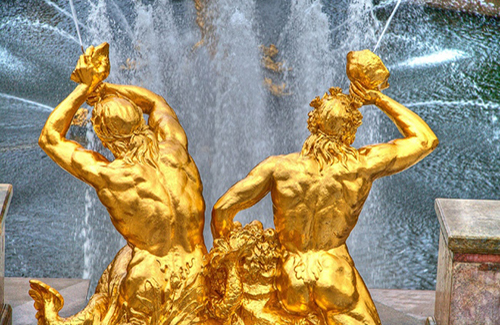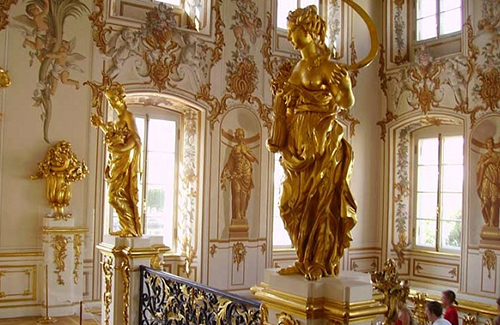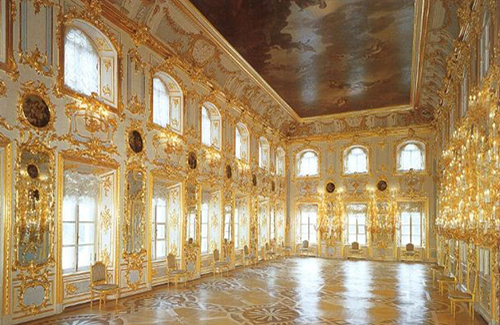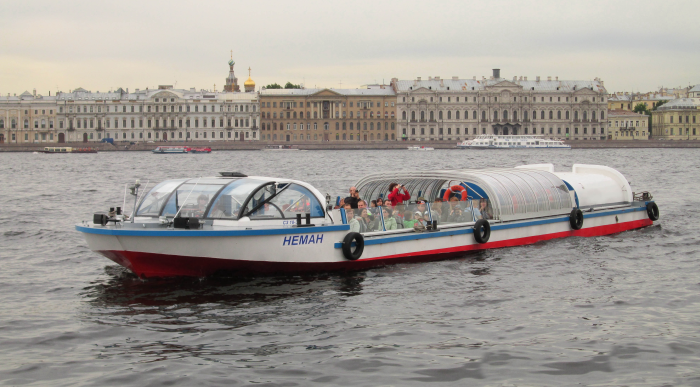NSP2018 offers several social events such as the Welcome party (Hotel New Peterhof, May 07), workshop banquet (May 11), an excursion to Peterhof Grand Palace and Lower Park and a boat trip to St. Petersburg city and the Hermitage Museum.
Peterhof
Peterhof is a town situated 30 km west of St.Petersburg and world famous for its unique 18th-early 19th century ensemble of parks, palaces and fountains, a UNESCO World Heritage site. Altogether the parks cover as much as 230 hectares and are located on 2 levels made up by a natural terrace overlooking the Gulf of Finland. The centerpiece of the entire complex is incredibly impressive Great Cascade of fountains, the Grand Palace and the Marine Canal.
The building of the Grand Palace as an Imperial summer residence began in the reign of Peter the Great and continued through subsequent decades by many famous architects with different architectural styles: from the splendid baroque halls by Bartolomeo Rastrelli, to the dignified classical and ornate rococo rooms.
The role of a magnificent courtyard for the Grand Palace is played by the Upper Park set out like a formal French garden. Its whole layout with the green lawns, fountains and ponds of the broad parterre is centered on the palace emphasizing its splendor.
Forming a single whole with the Grand Palace is the Cascade with the impressive system of 64 fountains planned by Peter the Great himself. Together with 17 artificial waterfalls, 39 gilded bronze statues, decorative sculptures, bas-reliefs and a majestic grotto on the hill-slope the cascade is one of the finest fountain ensembles in the world.
From the terrace above the Great Cascade there is a splendid view of the Lower Park, which, in its turn, is famous for the astounding range and diversity of nearly 150 fountains – from monumental ensembles (the Triton) and cascades (the Chess Hill, the Golden Hill) to trick-fountains (spraying an unwary passerby). Some of them make up a single whole with smaller palaces and pavilions, such as, for example, Monplaisir (Peter the Great’s favourite little palace), Chateau de Marly, and the Hermitage Pavilion.




THE EXCURSION TO THE HERMITAGE
Thursday, May 10
11.45 – 13.45
The Hermitage is the largest museum in Russia, which ranks among the most important museums in the world, such as the Louvre, the British Museum, the Prado, the Metropolitan Museum. It was founded in 1764 by Catherine the Great, and has been open to the public since 1852. Its collections comprise over 3 million items. The museum occupies a large complex of 7 historic buildings along Palace Embankment and in Palace Square, including the Winter Palace (the former main Imperial residence built in 1762), and has branches in several other palaces in St.Petersburg. The collections are displayed in 6 departments: of Western European Art (from the 13th to the 20th centuries), Antique Art, Prehistoric Art, Russian Culture, Oriental Culture, and Numismatics.
During the 2-hour excursion you will be able to see the highlights:
- the interiors of the Winter Palace, including throne-rooms, ball-rooms, the Malachite dining-room, the Gold drawing-room, the Hanging garden;
- the collections of Italian Art (Botticelli, Leonardo da Vinci, Raphael, Titian, Veronese, Caravaggio, Michelangelo, Canova);
- Spanish Fine Art (El Greco, Ribera, Velazquez, Goya, Murillo);
- Dutch Golden Age (Rembrandt, Steen, Hals);
- Flemish Baroque (Rubens, van Dyck);
- French Art of the 15th – 18th centuries (Watteau, Boucher, Falconet);
- The collection of Classical Antiquities.
THE TOUR ALONG THE RIVERS AND CANALS OF ST.PETERSBURG
Thursday, May 10
15.30 – 18.00
This is one of the most extraordinary and romantic ways to see the city. St.Petersburg is quite different from the water point of view! The boat will take you along the most picturesque embankments, as well as hidden parts of the city.

Water is an essential part of St.Petersburg’s charm. The soft shimmer of the canals, their poetic bridges connecting dozens of islands, the expanse of the main river, the full-flowing Neva, the embankments lined with palaces, mansions and cathedrals – all this explains why the city is often called the “Venice of the North”. St.Petersburg has about 50 rivers, streams, channels and canals, which divide it into 44 islands in the delta of the Neva. There are about 500 bridges, including 22 drawbridges to let the ships pass during the navigation season.
The tour starts at the widest point of the Neva, where it splits up into several arms. The river has its source in Lake Ladoga and empties into the Gulf of Finland. It is always deep (8–11 meters on average) and carries as much water to the sea as the Nile. The spot provides a breathtaking view of several architectural ensembles, including:
- The Peter and Paul Fortress, which construction gave birth to the city. It was built to protect the outlet into the Baltic Sea during the Great Northern War with Sweden. St.Peter and St.Paul Cathedral with its fine gold spire – the burial place of the Russian tsars;
- The Spit of Vasilyevsky Island – the former sea port, with the Rostral Columns (used to serve as beacons), and the former Exchange building;
- University Embankment with the buildings of the Russian Academy of Sciences and St.Petersburg State University;
- Palace Embankment with the Hermitage buildings and several former palaces of Grand Princes.
You will go upstream under the huge arches of the drawbridges, heading for the system of smaller rivers and canals: the Fontanka river, the Griboedov and Kryukov canals, the Moika river. They will make you feel the atmosphere of the old part of the city. They are spanned with dozens of bridges, and the banks are faced with granite and lined with an endless stream of palaces, mansions, residential buildings, sculptural monuments, gardens and parks. Most of the mansions are now turned into museums, concert halls, museum-flats of famous Petersburgers (e.g. Pushkin’s House), research and educational institutions. There are many romantic staircases leading down to the water and decorated with vases, torch-holders, sculptured cast-iron and bronze lions, mysterious griffins and sphinxes. Among the most famous sites are:
- The Summer Garden with its marble 18th-century Italian sculptures, the elegant lacy railing, and Peter the Great’s Summer Palace;
- Anichkov Bridge with the sculptured groups “The Horse Tamers”. It carries the city’s main avenue, Nevsky Prospekt, over the Fontanka river;
- The Mariinsky Opera and Ballet Theater;
- The graceful Nikolsky Marine Cathedral with the white columns against the pale-blue walls and gilded domes;
- The Yusupov Palace, which once belonged to one of the richest and influential princely families. It also went down in Russian history as the place where Grigory Rasputin was assassinated;
- St.Isaac’s Cathedral, the third highest domed cathedral in the world, mostly famous for its mosaic icons, malachite and lapis lazuli columns of the iconostasis, huge monolithic granite exterior columns, and the 22-meter gilded dome.
BUS EXCURSION ALONG THE OLD PETERHOF ROAD
Thursday, May 10
18.00 – 19.30
On the way back to the hotel after the tour of St.Petersburg, the bus will be taking you along the Old Peterhof Road, which was founded in 1710 as a highway connecting the city with the future Royal summer palaces and suburban estates of Russian noble families, the plots for which Peter the Great allocated on a 40-kilometer stretch of land south-west of St.Petersburg. In the course of time, it became a unique landscape and architectural system of palaces, mansions, gardens and parks of various architectural styles.
Nowadays, the road brings you past different historical areas: from the 18th century to modern ones, which are under construction. You will see dwelling houses typical for each period, as well as some industrial constructions, including St.Petersburg Shipyard and a huge machine-building complex. The road also runs through the areas that were heavily destroyed during the siege of the city in World War II, so the most significant spots of those days are marked with the war memorials. As the bus is approaching the southern border of St.Petersburg, there are more and more green areas: parks, ponds and the former mansions of Russian aristocracy. Among the most famous and best preserved are the following:
- Konstantin Palace in the Strelna estate. This grand residence was founded by Peter the Great and later became the country estate of grand dukes (Konstantins) of the Romanovs House. Having been ruined during the Nazi occupation in World War II, it is now fully restored and has a status of the National Congress Palace. Together with the park, it combines the functions of a State residence and a modern business, museum and exhibition center;
- Alexandria Park. The ensemble of park, palaces and pavilions was the country residence of the tsar’s family in 1830-1917, given by Nickolas I to his wife Alexandria as a present. It is a vast landscape terraced park (115 hectares). The romantic atmosphere of hills, alleys, small paths and lawns is enhanced by palaces and chapels in Gothic style.
